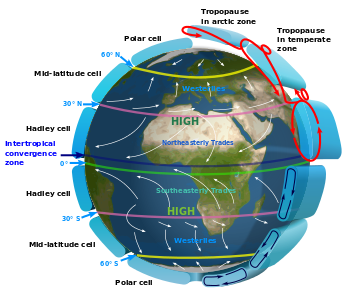What are the circulation pattern cells in the earth's atmosphere near the equator?
1 Answer
Hadley cells
Explanation:
I believe you are referring to Hadley cells.

https://en.wikipedia.org/wiki/Hadley_cell
The diagram above shows all the circulation cells of the atmosphere, and you can see the ones just north and south of the Equator are called Hadley cells (named after George Hadley who first describe the mechanisms for trade winds).
At the equator the high amount of solar energy heats the atmosphere. There is a lot of moisture at the equator (there is a lot of ocean at the equator), and that adds water vapor to the atmosphere. Water vapor has a lower weight than nitrogen (the primary component of the atmosphere) and that lowers the weight of the atmosphere and therefore the pressure. Furthermore, as the air is heated it expands and that lowers the density causing upward motion of air. End result the air is rising.
As the pressure decreases with height the temperature decreases as well. This lowers the amount of water vapor the air can hold and cause precipitation. This is important later.
With lower pressure at the equator, the pressure gradient force (force causing air to move from areas of high pressure to areas of low pressure) brings air to the Intertropical Convergence Zone (named due to the incoming air converging). End result of this is surface winds move air toward the equator.
With air converging and rising at the equator, when it reaches the tropopause (top of the troposphere) it is forced to move outward away from the equator. As it moves further away, and as has further precipitation the weight of the air increases. This causes descending motion of air at around 30 degrees latitude. This air, as it descends also warms from the increase in pressure. This further dries out the air and increases pressure. This is why if you look around the globe you will see a lot of deserts at around 30 degrees latitude.
As you can see from the global diagram above this closes the system, giving you your Hadley cell.
